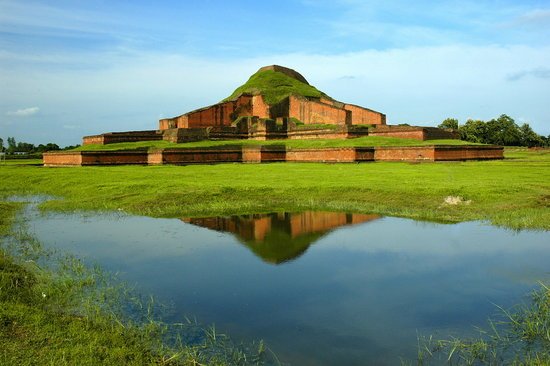Somapura Mahavihara in Paharpur, Badalgachhi Upazila, Naogaon District, Bangladesh.
.jpeg)
.jpeg)
.jpeg) Paharpur Buddhist Monastery, also known as Somopura Mahavihara is one of the most important ancient sites in our country. It was declared as a World Heritage site in 1985. There were monasteries which were built in Pala period in Bengal and in Magadha. Dharampala Vikramsila was the pioneer in building this monastery. He was the king of Varendi Magadha. It is a large square rectangle which is approximately 920 feet. The entrance is from the north side. The outer walls of monastery point towards the sanctuary area which is designed with rows of walls. The total number of cells are 177. The central sanctuary has a solid ground plan which ascents in 3 terraces above ground level to a peak of 70 feet.
Paharpur Buddhist Monastery, also known as Somopura Mahavihara is one of the most important ancient sites in our country. It was declared as a World Heritage site in 1985. There were monasteries which were built in Pala period in Bengal and in Magadha. Dharampala Vikramsila was the pioneer in building this monastery. He was the king of Varendi Magadha. It is a large square rectangle which is approximately 920 feet. The entrance is from the north side. The outer walls of monastery point towards the sanctuary area which is designed with rows of walls. The total number of cells are 177. The central sanctuary has a solid ground plan which ascents in 3 terraces above ground level to a peak of 70 feet.
Somapura Mahavihara (Bengali: সোমপুর মহাবিহার Shompur Môhabihar) in Paharpur, Badalgachhi Upazila, Naogaon District,Bangladesh (25°1’51.83″N, 88°58’37.15″E) is among the best known Buddhist viharas in the Indian Subcontinent and is one of the most important archeological sites in the country. It was designated a UNESCO World Heritage Site in 1985.
A number of monasteries grew up during the Pāla period in ancient Bengal and Magadha. According to Tibetan sources, five great Mahaviharas stood out: Vikramashila, the premier university of the era; Nalanda, past its prime but still illustrious; Somapura Mahavihara; Odantapurā; and Jaggadala. The monasteries formed a network; “all of them were under state supervision” and there existed “a system of co-ordination among them … it seems from the evidence that the different seats of Buddhist learning that functioned in eastern India under the Pāla were regarded together as forming a network, an interlinked group of institutions,” and it was common for great scholars to move easily from position to position among them.
The excavation at Paharpur, and the finding of seals bearing the inscription Shri-Somapure-Shri-Dharmapaladeva-Mahavihariyarya-bhiksu-sangghasya, has identified the Somapura Mahavihara as built by the second Pala king Dharmapala (circa 781–821) of Pāla Dynasty. Tibetan sources, including Tibetan translations of Dharma Kayavidhi and Madhyamaka Ratnapradipa, Taranatha’s history and Pag-Sam-Jon-Zang, mention that Dharmapala’s successor Devapala (circa 810–850) built it after his conquest of Varendra. The Paharpur pillar inscription bears the mention of 5th regnal year of Devapala’s successor Mahendrapala (circa 850–854) along with the name of Bhiksu Ajayagarbha. Taranatha’s Pag Sam Jon Zang records that the monastery was repaired during the reign of Mahipala (circa 995–1043 AD).
The Nalanda inscription of Vipulashrimitra records that the monastery was destroyed by fire, which also killed Vipulashrimitra’s ancestor Karunashrimitra, during a conquest by the Vanga army in the 11th century, assumed to be an army of the Varman rulers. About a century later Vipulashrimitra renovated the vihara and added a temple of Tara.
Over time Atish’s spiritual preceptor, Ratnakara Shanti, served as a sthavira of the vihara, Mahapanditacharya Bodhibhadra served as a resident monk, and other scholars spent part of their lives at the monastery, including Kalamahapada, Viryendra and Karunashrimitra. Many Tibetan monks visited the Somapura between the 9th and 12th centuries.
During the rule of the Sena dynasty, known as Karnatadeshatagata Brahmaksatriya, in the second half of the 12th century the vihara started to decline for the last time. One scholar writes, “The ruins of the temple and monasteries at Pāhāpur do not bear any evident marks of large-scale destruction. The downfall of the establishment, by desertion or destruction, must have been sometime in the midst of the widespread unrest and displacement of population consequent on the Muslim invasion.
now i really want to visit this place.😍😍 Historical place in your post.
Yeap
WOW!... GREAT POST!
Thanks ..